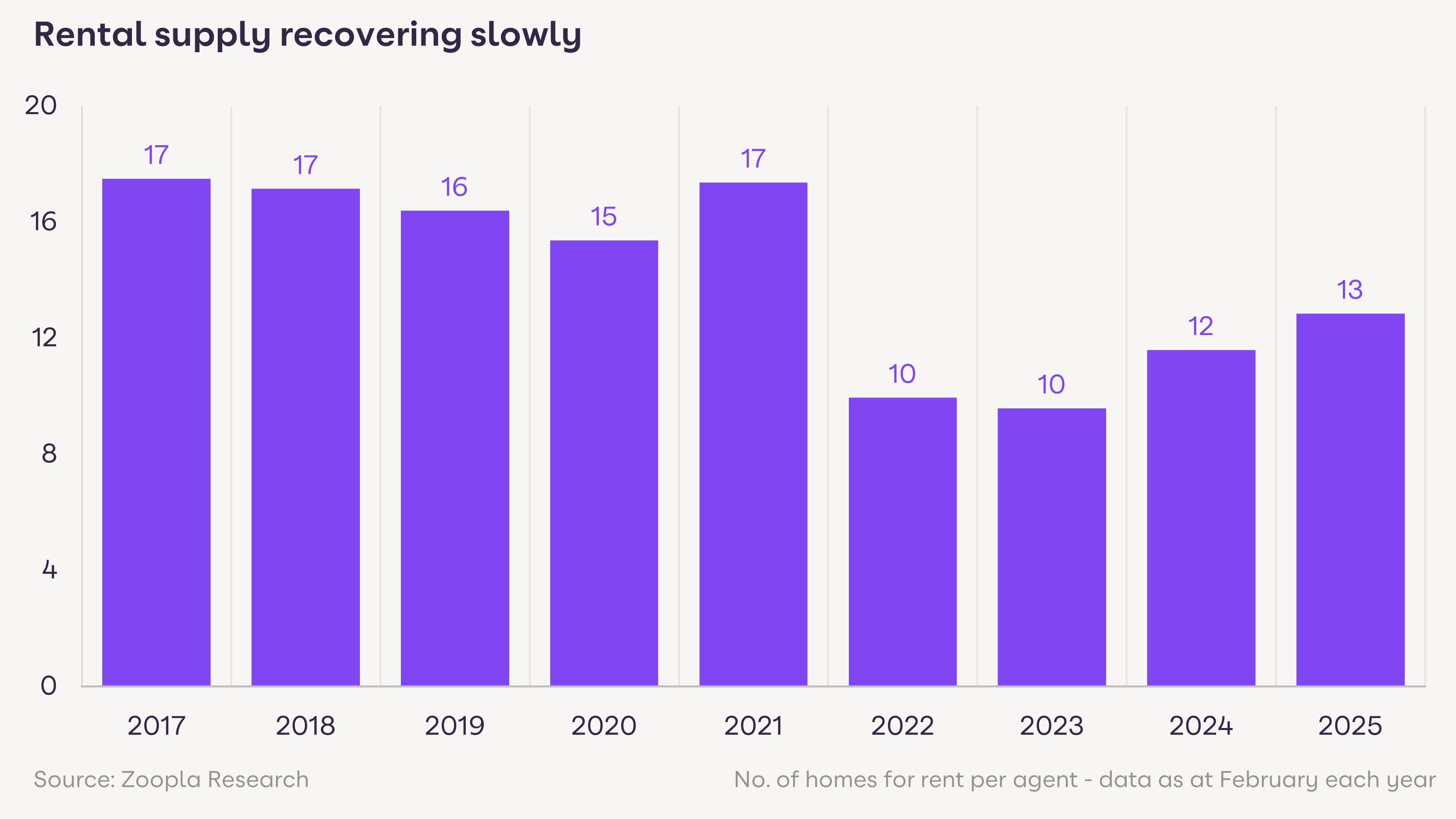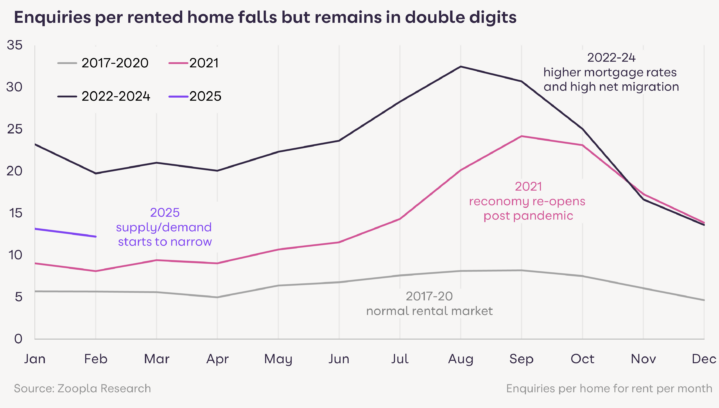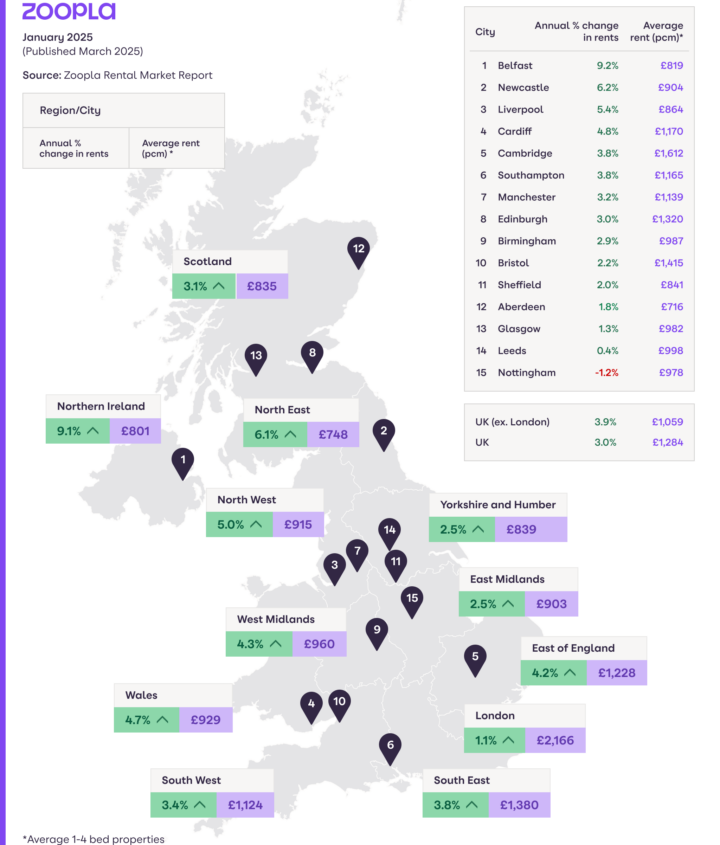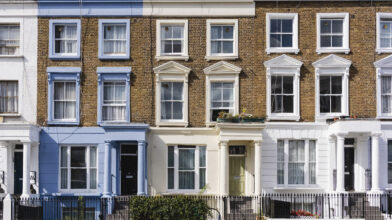Search
close
Stay in the loop with our monthly newsletter, bringing you a fresh take on all things property.
Form funnels into a Pardot list to update Prospect sign up for Estate Agent and New Homes
"*" indicates required fields
Annual rental inflation for new lets, UK
Renters chasing each available rental home
Rental inflation in London
“Rental inflation has slowed, which will be welcome news to renters, but there are still 12 people chasing every home for rent. Growing supply is essential to support those on lower incomes and policy reforms for the rental market need to minimise the impact on supply.”
Rental market conditions are steadily improving after 3 years of chronic undersupply and excess demand. There remains a mismatch in supply/demand, which is not going to rebalance anytime soon, meaning a continued upward pressure on rents.
Rents are increasing at their lowest rate for 3.5 years. This has more to do with worsening rental affordability than an improvement in the supply of homes for rent. The average agent has 13 homes for rent, up from a low of 10 in 2023 but still 22% below the pre-pandemic average. Household cost of living data also shows that living costs for private renters rose faster than any other group in 2024.
The private rental market needs more supply to boost choice and help renters on lower to middle incomes who have struggled to keep pace with a 24% increase in rents for new lets over the last 3 years.

The private rental market in England is facing some major policy changes, which are likely to limit new investment and growth in the stock of rented homes. This follows on from tax changes and higher mortgage rates, which have caused many landlords to exit, keeping rental stock levels static at c5.5m since 2016.
The new Renters’ Rights Bill is likely to come into force later in 2025, resetting the relationship between renters and landlords, but also increasing the complexity and cost of being a landlord. Investment in new supply will be lower as landlords assess the impact.
In addition, the Government is also consulting on the need for private rented homes to have an energy rating of ‘A’, ‘B’ or ‘C’ before they can be let out from 2028. Almost half (45%) of rented homes require investment to get from a D rating to a C rating. Almost 1 in 5 (16%) of private rented homes are currently ‘E’, ‘F’ or ‘G’ rated, and as a result would be more at risk of being lost from the rental market.
The average monthly UK rent is £1,284, 3% higher than last year. This is the lowest rate of growth for 3.5 years and more than half the rate a year ago (7.4%) as the supply/demand imbalance narrows.
There has been a modest 11% increase in the number of homes available for rent over the last year, while rental demand is down by almost a fifth (-17%). The mismatch between supply and demand remains a challenge, with 12 renters currently chasing each home for rent. This is almost half the level of competition for rented homes recorded between 2022 and 2024 (when rental demand was at its strongest) but is still double pre-pandemic levels.

Rental demand has cooled across all regions and countries of the UK over the last year. This is largely a result of lower levels of immigration for work and study, as well as greater first-time buyer demand, most of whom originate from the rental market.
The average annual cost has risen by £3,000 over the last 3 years, and these growing renting costs are also likely to be suppressing demand for new lets, encouraging renters to stay put for longer to avoid higher costs from moving home which also reduces supply.
The number of homes for rent has increased in all areas of the UK except in the West Midlands, where supply is 10% lower than last year. The number of homes for rent has grown most in the North East (23%) and Scotland (29%). Rising supply is welcome news for renters, but supply remains below pre-pandemic levels across all areas except for the East Midlands.
Rental inflation ranges from a low of 1.1% in London to 6.3% in the North East and 9% in Northern Ireland. In addition to London, rental inflation has slowed rapidly in Scotland and the East Midlands over the last year, as the number of homes available to rent increases.
Rents are rising more slowly than average earnings (6% annual rise) across most cities, which will be welcome news for renters who have faced steep rent increases over the last 3 years.
At a city level, annual rental inflation ranges from -1.2% in Nottingham and 0.4% in Leeds to 6.2% in Newcastle, highlighting how localised changes in supply and demand can shape the trajectory of rental costs. Rising levels of rental supply in Nottingham are impacting rent levels.

We expect demand for rented homes to continue to exceed available supply in 2025, but to a lesser extent than we’ve seen in the recent past. The overall stock of rented homes is unlikely to increase in size in the coming years due to policy changes impacting profit margins and operating complexities for landlords.
Lower levels of net migration have helped to moderate rental demand – net migration in 2024 was estimated to be 728,000, which is down 20% from 906,000 in 2023. This decline is expected to continue into 2025 due to stricter visa policies and increasing levels of emigration, particularly among international students.
Affordability remains the primary constraint on rental inflation and is the primary factor behind rents rising at their lowest rate since August 2021. However, there remains scope for rents to rise at an above-average rate in areas where renting remains more affordable, including areas adjacent to big cities.
We expect rents to increase by 3-4% over 2025 as slower growth in large cities is offset by faster growth in more affordable markets. Minimising the negative impacts of policy change on supply is essential to help most renters, who are on low to middle incomes.
Note: The Zoopla rental market index is a repeat transaction index, based on asking rents and adjusted to
reflect achieved rents. The index is designed to accurately track the change in rental pricing for UK housing.



House price inflation slows to 1.8% as the supply of homes for sale outpaces the growth in sales agreed

The housing market gets off to its strongest start in three years, with new sales agreed up 12 per cent on 2024.

The housing market gets off to its strongest start in three years, with new sales agreed up 12 per cent on 2024.